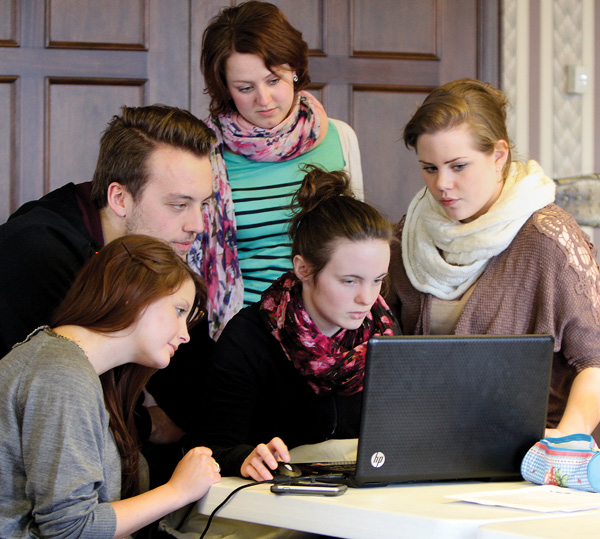German students will present ideas to develop Mahoning River


A group of students from the Technical University of Dortmund in Germany is working on a proposal to develop land in Youngstown along the Mahoning River. The students, from front left, are Romina Loch, Jenny Kerkoff and Madita Bush, and, back from left, Adam Berecki and Valerie Heeks.
YOUNGSTOWN
A group of 13 city planning students, with the assistance of two professors, from a German university will present a number of recommendations as to how Youngstown can develop the city’s downtown riverfront area at a conference today.
The group from the Technical University of Dortmund will offer suggestions such as clearing space for restaurants and downtown apartments along the river, and turning vacant buildings into recreational facilities.
Dortmund, in Germany’s Ruhr Valley, used to be a major industrial area, particularly for steel and coal, said Dr. Thorsten Wiechmann, chairman of Dortmund’s regional planning and planning theory department.
The Ruhr Valley saw its economic base collapse in the late 1960s and early ’70s. By the late 1980s, it started to change its image, turning abandoned factories into cultural and entertainment facilities and focusing on recreation along the Ruhr River, he said. At the same time, the area embraced its industrial past, he said, by building monuments honoring its history.
The students and professors came to Youngstown on March 18, met with various political and planning officials, and will give their presentation at 2 p.m. today at a German Marshall Fund of the United States’ program titled “Policies and Strategies in Shrinking Cities: The Case of Youngs-town, Ohio,” at the Covelli Centre. The fund is a renowned nonprofit organization known for its work in forging alliances and shared experiences between cities in the United States and Europe.
The students have studied Youngstown since October before coming to the city. While here, they are staying on the fourth floor of the former PNC Bank Building at 16 Wick Ave. The floor used to be PNC executive-management suites when the bank was located there.
“There’s a lot of room for change in Youngstown,” said Jannik Huelsbusch, a 22-year-old Dortmund student. “Youngstown has a lot of potential in its downtown. This plan would help the Mahoning River and the downtown area. We want to make downtown more lively and have more people live in it.”
The river is a great attribute that isn’t used, he said.
Huelsbusch said he was somewhat surprised by the appearance of the city.
“I expected it to be worse with a lot of vacant and torn-down buildings,” he said.
Wiechmann visited Youngstown about 12 years ago.
“Downtown was as worse as it could be,” he said. “The comeback now is amazing to see.”
Isabella Konarski, a 22-year-old student, also said she thought the city “would be worse than it is. With the huge population loss, I thought it would be a city without a downtown and urban life and be vacant.”
One suggestion she has is to have street artists paint an old industrial building celebrating the area’s steel history.
Konarski said she’s been impressed by the reception the students have received from residents.
Marian Gunzel, the other professor on the trip, said though Youngstown’s population is shrinking, it is becoming a more vibrant city.
“We hope to be a part of that and have the students learn from this experience,” he said.
Ian Beniston, deputy director of the Youngstown Neighborhood Development Corp., said he met Wiechmann at a conference in New Orleans last year and persuaded him to bring a group of students to Youngstown.
“Focusing on the river is something that hasn’t been done in Youngstown,” Beniston said. “We hope people will embrace the vision” presented by the students.
 43
43
